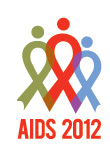 For the first time, researchers have documented a dramatic change in adult life expectancy in an HIV-endemic region—in this case, KwaZulu-Natal, a particularly hard-hit rural province in South Africa—according to data presented Tuesday, July 24, at the XIX International AIDS Conference (AIDS 2012) in Washington, DC.
For the first time, researchers have documented a dramatic change in adult life expectancy in an HIV-endemic region—in this case, KwaZulu-Natal, a particularly hard-hit rural province in South Africa—according to data presented Tuesday, July 24, at the XIX International AIDS Conference (AIDS 2012) in Washington, DC.
According to Jacob Bor, a doctoral candidate at Harvard University’s School of Public Health, the average life expectancy in the area increased by 8.2 years between 2003 and 2011.
Throughout modern history, life expectancy has increased globally. But in countries hardest hit by the AIDS epidemic, where HIV prevalence remains high, AIDS has reversed these life expectancy gains. In South Africa and nearby Swaziland, for example, life expectancy averaged 67 years in 1990. By 2010, the average life expectancy was 59 years in South Africa and 52 years in Swaziland.
While various research teams have analyzed modeling data and concluded that life expectancy in these and other endemic countries are increasing, thanks to the increasing availability of antiretroviral (ARV) therapy, very little hard data from observational studies has been reported.
In turn, Bor and his colleagues estimated adult life expectancy for 15-year-old KwaZulu-Natal men and women using data from a large cohort involving nearly 150,000 residents of the province. Bor noted the exceptionally high HIV prevalence in the area; roughly 28 percent of all adults in KwaZulu-Natal are living with HIV.
For the analysis, Bor’s team assessed the distribution of life spans in 2003, prior to the rollout of ARV therapy in South Africa, and again in 2011. Using these life expectancy data, the researchers were then able to compute a cost-benefit ratio to help guide economic decision-making of governments and donors considering levels of support for ARV rollout in the future.
Following ARV rollout in KwaZulu-Natal, the study showed that life expectancy in the area jumped from 52.4 years in 2003 to 60.6 years in 2011. Bor added that men experienced a gain of 6.6 years, while women experienced a gain of 9.5 years.
But what are these gains worth, at least financially, and how do these gains compare to the cost of ARV treatment? According to the analysis conducted by Bor’s group, ARV rollout in KwaZulu-Natal has led to lifetime per-capita gains of $26,000 for 15-year-olds in 2003 to $79,000 in 2011.
This is up to six times larger than the per-capita cost of providing lifelong ARV to every person who contracts HIV in KwaZulu-Natal, estimated to be $13,400, based on 2012 cost figures from the President’s Emergency Plan for AIDS Relief (PEPFAR).
“ARV therapy roll-out has resulted in large increases in adult life expectancy in rural South Africa,” Bor and his colleagues concluded. “The economic value of these health gains far outweighs the costs of treatment.
“These findings,” he added, “provide critical evidence for government and donors debating levels of support for ARV rollout.” They also have “implications for economic decision-making of individuals and governments regarding investment in the future."
Advertisement
Advertisement
Advertisement






Comments
Comments